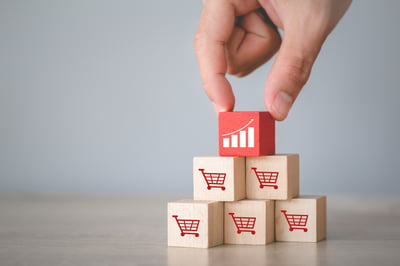
Each and every company today aspires for efficient growth.
However, how do you achieve an efficient growth level despite the market being seemingly so saturated? What do you do if your marketing efforts seem not enough, your sales team doesn't bring many leads, and nobody even sees how great your product is? The answer is simple: you adopt a product-led approach and let the product rule your sales.
This article is the only introduction to product-led growth you need. With graspable definitions, real-life examples, and practical tips, it will guide you through the world of product-led growth - the world of a growth revolution.
Today, SaaS is growing at a rapid speed, showing no signs of slowing down. It is projected to have a revenue of around $370 billion by 2024, surpassing a five year increase of $200 billion. The fastest-growing companies like Slack or Zoom set the example for other services willing to become big players. Agile and proactive businesses are at the forefront of innovation, customer loyalty, and success.
Very often, being product-led is what defines these businesses and makes them stand out from the rest. But what exactly does it mean to be a product-led SaaS company?
Everybody has probably heard terms like “freemium,” “a forever free version,” “free trial,” and alike. Well, all of them go together with the definition of product-led growth.
A product-led company makes its product a focal point of all company operations. All departments emphasize the product as the main driver to achieve scalable and sustainable development. The product becomes the main hero of the story, acquiring, activating, and retaining customers. Your website visitors smoothly become your users - the driving force behind your SaaS solution.
All of this sounds very good in theory. But one question remains: how to be product-led in practice?
You have probably heard of such companies as Zoom, Slack, Airtable, or Dropbox. The chances are high that you are an active user of at least one of them. The world of product-led growth is full of such big names, and each of these companies aims to solve their customers’ unique pain points. Well, they are genuinely succeeding in that!
Many people use these products before they even know what they are. Think back to the rise of video-conferencing: one of your colleagues probably sent you a message saying something like, “Let’s catch up, I’ll send you a Zoom invitation.” Before you knew it, you became a Zoom user, and the next time you wanted to catch up with someone yourself, you simply invited them to a call on Zoom.
The same thing happens with Dropbox. Imagine this realistic scenario: somebody had a file they wanted to share with you. They uploaded it to their team’s Dropbox storage and sent you the link. You opened the file, and… instantly became a Dropbox user!
That’s where the magic secret of a product-led approach lies: quality products spread like wildfire. You see a user-friendly interface, easily log in, use it for the first time without hiccups, and you are hooked.
To be genuinely product-led, your product needs to bring instant value for its users and solve their challenges in a way incomparable to your competitors. You offer value without asking anything in return - that’s your ‘forever free version,’ which is a very popular approach in product-led companies. Once your users love the product so much that they want more (and they indeed will if you deliver the value you promise), you can offer them to upgrade to a paid plan.
Again, your paid version should be a great value for money and provide an enhanced set of features. For example, Slack is the same whether it’s a free version or their Plus package, as they call it. However, when you become a paying user, you can get some additional features like an unlimited message archive, group video calls, and unlimited app integrations. If you need those - you pay for them and get the expected value. If you don’t - you are free to use the product without paying a cent.
Thus, a product-led approach means that users can play around with your service without any investment from their side. They can test out its features, solve their problems, meet particular needs, and only after make a purchase. Or not make it, but still be your dedicated customer and keep spreading the word about your service (which can be as simple as sending a link to a teammate!).
Every SaaS company can implement a product-led approach. From collaboration spaces to customer service solutions to video conferencing apps to companies providing branded visual assets, you can benefit from adopting product-led growth.
You might argue that every SaaS company is product-led to an extent. True, it’s impossible to succeed in this field without having a product that stands out. However, there is more to being product-led than simply having great and useful features. It takes the whole company being aligned towards the product, working in tune to develop it, promote it, and make the customers happy.
As you can see, the shift toward product-led growth takes significant efforts from every employee in the company. To understand this shift better, it’s essential to distinguish the critical differences between product-led growth and more traditional growth strategies.
When speaking about the traditional growth approaches, people usually mean a sales-led/marketing-led one. Let’s compare these two with product-led growth.
Traditionally, the sales funnel starts with setting up paid advertisements on Facebook, Instagram, Google, and whatnot. A potential customer sees the ad, interacts with it showing interest, and becomes a Market Qualified Lead (MQL). They then get into the hands of Salespeople to get the purchasing process going.
Salespeople can set up a call or use a live chat to talk the interested actor into buying the product. They go to great lengths, emphasizing the benefits, getting to know the person and the challenges they need to overcome, and personalizing the buying experience.
If the lead is ready to pay, they make a purchase and become a customer, being passed over to the Customer Success team. If they decide to stay with the product and do not quit their subscription, they can become advocates for the company, improving customer retention and lowering the churn rate.
Yeah, this is a very personalized process. But it is also very lengthy and tedious, and the customer is passed from department to department having conversations. They do not have a chance to try the product itself. Instead, they keep explaining their situation and being convinced how much they need the product. Unfortunately, often it’s all talk and no action.
As already mentioned, the primary differentiating factor for product-led growth is that the product itself guides the customer and introduces them to their first steps of the sales funnel. Everyone interacting with a product is already a customer in this case, and everyone converts at their own pace.
Advertisements are not the primary communication channel in product-led companies. They are in place, but rather than focusing solely on ads, such companies implement product marketing. Using knowledge sharing, thought-leadership, and value-driven content strategies, marketers focus on encouraging the customers to get interested in the product and play around with it.
These clients are called Product Qualified Leads (PQLs). Being able to test the product before paying any money seems to be very attractive: PQLs convert 3-4x higher than MQLs. Of course, the Salespeople are still there - the profession is not dying because of the shift towards product-led growth. They are more of the observers in this case - they keep a careful eye on the customers and are ready to step in and assist them in case any questions or issues arise.
As for customer success specialists, they are not simply a team - it should be the primary goal of any product-led company to achieve customer success. As simple as that! Assisting customers’ needs and being their reliable point of contact is a massive part of the product-led vision.
The key here is not to be too nosy - your product will onboard the customers itself just fine. It might sound scary, but just go with the flow - statistics say that currently, around 75% of B2B buyers prefer a self-onboarding model of purchasing. Thus, you get your customers because of who you are, not because of what you tell them.
As you can see, product-led companies have a great potential to grow fast with very little money spent. It’s a true case of “actions being louder than words” when the products bring more and more interested customers who then convert into paying users.
Sounds tempting, right? Let’s get into more specific details on how you can ensure that a company is product-led and use this approach to the maximum benefit.
The key starting point is to make end-users the focal point of all your company activities. It’s vital to change the mindset of the whole organization: it’s not supervisors who will make decisions from now on, but the users. The economics of attention rules the business world, and customers make their decisions fast. If you do not satisfy them by constantly gathering feedback and enhancing your product quality, it simply will not work.
Here is what a Growth Expert Eduard Klein says about the rise of the end-user:
"You need to focus not on the buyer but on who uses the product in the end. Allowing the product to guide the user through the onboarding is critical if you want to keep the acquisition cost and the churn rate low. User interfaces have to be intuitive, clean and personalized to keep the user’s attention while showing your product."
As mentioned before, turning the company into a product-led one is a significant shift, both in operations and attitudes. Wondering what steps you need to take to secure efficient product-led growth? Here is a list of essential activities to bear in mind.
Remember that every single employee has an impact on the product from now on. The whole company is involved in developing the product. Customer Success is at the forefront of customer communication, gathering feedback, and analyzing what customers currently lack. Marketing works on pitching the new features, delivering value through comprehensive texts, and increasing organic traffic of the company website to allow more visitors to get acquainted with the product.
And there is, of course, the product team - the heroes behind building the product and delivering value. Frankly speaking, at a certain point in your product-led journey, the whole organization becomes a product team, a customer success team, and a marketing team. This way, you work very closely with the entire team, you are aligned to improve the product, and your efforts are diversified. At the same time, everybody takes equal responsibility for the product’s success.
As your main goal is to deliver value no matter what, you need to make sure everything works smoothly. In the end, you cannot be product-led if your product is not good enough to lead you. You need to conduct regular quality audits to ensure that your product delivers the value your users seek. Take a step back and ask yourself some questions:
This reflection can become a good foundation for your teams’ next steps in improving the product and the customer experience.
In product-led growth, you aim to create exceptional user experiences, which is impossible without tracking your progress. At first, you might succeed by purely following your gut, but you can only get a deep quality insight into product usage by implementing analytics tracking.
Some of the most important metrics include net churn, customer lifetime value, virality, product-qualified leads, average revenue per user. In general, you should choose primary and secondary metrics to follow that will correspond with your company and product vision. You can find a more detailed explanation of each of them below, so keep on reading.
The key stage in your product-led approach planning is the actual experimentation with the (almost) ready product. Take some time to think about specific guidelines and structures for the experimentation processes and get down to experiment ideation. As mentioned before, product-led growth means the whole organization is involved in product development. Thus, make sure everyone does their part at this stage, too.
It’s vital to distinguish specific areas for your trial and error approach - think about what growth themes have the highest potential to drive your product development. Maybe it’s acquisition where you can play with acquisition landings and models? Or engagement where you learn how to encourage frequent product usage better?
Identify the most significant growth opportunities, analyze the data, and build growth models for those spheres. Remember that no matter how good your ideas are, they are all mere hypotheses at first, so be ready to ‘kill your darlings’ if needed.
Another great idea at this stage is to work on the management of your expectations. There will be friction, and there will be churn at first. However, you need to meticulously analyze the feedback you get and fast-track the improvement to satisfy the customers.
Remember that product-led experimentation never stops. Even if you are a giant like Zoom, there will always be continuous and careful testing of what your customers could fall in love with. But don’t fret – with the right mindset and data-driven decisions, your product will drive itself to success and make your users happy.
No doubt, the rising popularity of product-led growth happens for a good reason - this approach seems to be highly beneficial both for companies and their users. Here are some of the reasons to consider a product-led approach:
As mentioned above, good products indeed spread like wildfire. With easy self-onboarding, no waiting time, and no unnecessary interactions with a lot of marketing/sales personnel, you get new users literally at one click. And when so many people can try the product for free, they can tell many others about it.
The product promotes and advertises itself. Your team doesn’t focus on how they can bring more users. Instead, everybody is busy thinking about how the product can provide an exceptional user experience and make customers more successful. It’s a great mindset to have.
You don’t need any specific webinars or calls introducing customers to your product. Neither do you need any demo versions. Your customers onboard themselves with a few clicks and see your product’s value right away. So, you convert your website visitors into paying customers with barely any cash spent while your users get the promised value instantly - a real win-win story.
Being easily scalable and growing sustainably, product-led companies are in for going international very fast. You don’t need sales personnel focusing on multiple geographical locations and languages - you have a funnel open to anybody anywhere in the world because of the freemium model. You didn’t talk to sales-reps from Dropbox to learn the product’s features, did you? You just clicked on the link and used the service. With such easy and hands-on value delivery, products like Dropbox skyrocket.
Your product should provide the value promised and do it instantly, which is the whole point of product-led growth. We live in a society that is ruled by short attention spans and the desire for instant gratification. If you are good with timing, expect great results.
There are numerous metrics you can follow on your way to product-led success. At the initial stage, it might be a good idea to assess which of them can be classified as primary and secondary. Below you will find a list of some key metrics to consider for your product-led SaaS solution.
The average revenue per user is the average amount of money you can expect an individual to spend. It is a great indicator of your overall business performance that can highlight a way towards further improvement.
ARPU is calculated when you divide your total MRR (Monthly Recurring Revenue) by the total number of users. ARPU is a convenient instrument to calculate how much you make from different user segments. Is your regulars’ ARPU indeed lower than your fans’? It’s worth checking!
Customer lifetime value predicts how much revenue you can make from a single user during their whole customer journey. Just like ARPU, it can come in very handy in identifying promising customer segments.
There are numerous ways to do the math here. One of the most popular formulas goes as follows:
Customer lifetime value = (Customer revenue Customer lifetime) - cost of acquisition and maintenance
The importance of CLV is hard to overstate - with many metrics available, it is still one of the most crucial ones. Why is it so? Well, it’s because it doesn’t only show what you have right now but allows you to have a peek into the future and predict how valuable your customers will be to you during different stages of their customer journey.
To put it simply, net churn means how much money you lose after accounting for new and expansion revenue. It can be a hard pill to swallow initially, but some customers will ultimately leave your product. There will be losses in the beginning, and there will be losses when you are a giant company - that’s how business works. Calculating your net revenue churn is important if you want to look at your company’s overall health.
To estimate your net revenue churn, use this formula:
Net revenue churn = (Revenue lost in period - New and expansion revenue) Revenue at the beginning of the period
Product-qualified leads are your activated users, the ones who have already experienced the value of your product. Calculating this metric is just a matter of counting those users. However, you need to clearly define who is a PQLs in the case of your product.
Identify the activation moment and the users’ steps to indicate that they are ready to progress in their customer journey. It can be done by gathering customer feedback, conducting user interviews, and doing A/B testing to figure out the specific actions associated with activation and retention.
The virality effect happens when your product’s rates of adoption start increasing exponentially with every new user. For such an effect to occur, every user should be able to promote your product easily (e.g., by sending a link to a colleague). If you see that your virality rates are increasing, it means that you are doing a good job keeping customers happy and satisfied.
To estimate virality rates, you can use this formula:
Virality rates = C(0) k = Number of customers at end of period
In this case, k is a coefficient measuring the number of new users that each already existing user can convert.
For your outline, you only need bullet point descriptions of content you plan to write
Visme is an all-in-one workshop that helps businesses and individuals build a solid visual brand. From presentations to infographics to videos to reports to social media images, Visme empowers teams and individuals to create all kinds of branded visual assets.
The product is unique because it’s not just a design tool, a video maker, or a presentation maker. It’s the go-to platform that people can rely on for all their visual content creation needs. Beyond design tools, Visme offers team collaboration, online sharing, and brand management features.
Visme is a truly product-led company. Here is what Farzad Rashidi, the Director of Marketing at Visme, says about their approach:
"Since our inception in 2013, our primary focus at Visme has been our product.
With our freemium model, we have always been able to hand over the “keys” to our customers to try our product and its features for as long as they like before they decide to buy and have the features of our platform do the selling.
Another significant factor in our product-led growth has also been our team functionality, enabling users to invite their colleagues to collaborate throughout the creation process and share their content, indirectly introducing Visme to a larger audience."
Visme’s example shows how important it is to always listen to your customers and make sure the product caters to all their needs. Their customers didn’t want a second PowerPoint but a unique ecosystem that can take care of all their visuals. And they delivered it!
Mailshake is an email automation solution focusing on delivering a great customer experience. They value a diversified approach and involve the whole company in making the product as valuable for their users as they promise.
Sam Molony, a Marketing Specialist at Maishake, highlights:
"Marketing and product departments work together almost inseparably, constantly coming up with new angles and feature pitches to make the customers excited and willing to try them. From here, it’s all about building those features and making them a reality."
Mailshake’s approach is an excellent example of being ready to ‘kill your darlings’. A feature may be significant and very dear to the team. Still, if no one can find an appropriate marketing value, it’s better to put it on hold.
Moosend is a solution focusing on email communication. Their platform provides features like email marketing, automation, tracking, e-commerce AI, segmentation, and many more. Traditionally for a product-led SaaS company, they have a freemium version of their product with practically all the features but with certain limitations.
Another important thing for a product-led company is constantly gathering customer feedback and tailoring the upcoming features to the users’ needs and desires, precisely what Moosend has been doing. This approach has proved very successful: despite the saturated email solutions market, Moosend is used by thousands of businesses worldwide to optimize their communication.
So, what are the most vital takeaways from these stories?
It’s undeniable that product-led growth is here to stay. This approach will only be gaining in popularity due to the continuous development of technology and digitalization of society. Let’s summarize the primary takeaways:
Marcin Stoll is the Head of Product at Tidio. He has over 7 years of experience in product management and sales. He enjoys working with SaaS companies and sharing his expertise with fellow product marketers.
Product-led growth (PLG) is a go-to-market strategy that centers on the product.
 by Ioana Sima
by Ioana Sima
Today, marketing automation isn’t just about convenience — it's the default standard for...
 by Agnishwar Banerjee
by Agnishwar Banerjee
In the world of SaaS, a new strategy has emerged that's turning traditional sales models on...
 by Yaakov Carno
by Yaakov Carno
Product-led growth (PLG) is a go-to-market strategy that centers on the product.
 by Ioana Sima
by Ioana Sima
Today, marketing automation isn’t just about convenience — it's the default standard for...
 by Agnishwar Banerjee
by Agnishwar Banerjee


